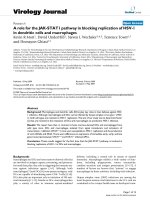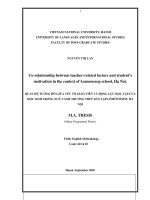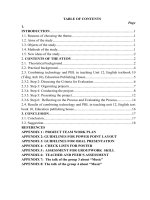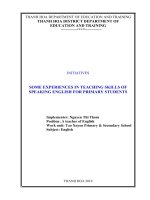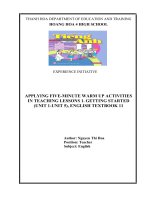Applying presentation and video production in teaching project of unit 1 family life and unit 8 new ways to learn new english textbook 10
Bạn đang xem bản rút gọn của tài liệu. Xem và tải ngay bản đầy đủ của tài liệu tại đây (965.15 KB, 20 trang )
THANH HOA DEPARTMENT OF EDUCATION AND TRAINING
HOANG HOA 4 HIGH SCHOOL
EXPERIENTIAL INITIATIVE
APPLYING PRESENTATION AND VIDEO PRODUCTION IN
TEACHING PROJECT OF UNIT 1: FAMILY LIFE AND
UNIT 8: NEW WAYS TO LEARN
-NEW ENGLISH TEXTBOOK 10
Author: Nguyen Thi Phuong
Position: Teacher
Subject: English
THANH HOA, YEAR OF 2019
TABLE OF CONTENTS
ORDER
1
1.1
1.2
1.3
1.4
1.5
2
2.1
2.2
2.3
2.3.1
2.3.1.1
2.3.1.2
2.3.2
2.3.3
2.3.4
2.3.4.1
2.3.4.2
2.4
3
3.1
3.2
CONTENTS
INTRODUCTION
RATIONALE
AIMS OF THE STUDY
SCOPE OF THE STUDY
METHODS OF THE STUDY
NEW FEATURES OF THE EXPERIENTIAL INITIATIVE
CONTENTS OF THE STUDY
THEORETICAL BACKGROUND
PRACTICAL BACKGROUND
IMPLEMENTATION AND SOLUTIONS
TECHNIQUES IN TEACHING PROJECT
WHY DO TEACHERS TEACH PROJECT?
ACTIVITIES TO PROMOTE PROJECT
WHAT IS A PRESENTATION?
WHAT IS VIDEO PRODUCTION?
APPLYING PRESENTATION AND VIDEO
PRODUCTION IN TEACHING PROJECT OF UNIT 1:
FAMILY LIFE AND UNIT 8: NEW WAYS TO LEARN NEW ENGLISH TEXTBOOK 10
APPLYING PRESENTATION IN TEACHING PROJECT
OF UNIT 1: FAMILY LIFE
APPLYING VIDEO PRODUCTION IN TEACHING
PROJECT OF UNIT 8: NEW WAYS TO LEARN
RESULTS AFTER APPLYING THE STUDY IN
TEACHING
CONCLUSION AND SUGGESTIONS
CONCLUSION
SUGGESTIONS
REFERENCES
APPENDIX
EXPERIENTIAL INITIATIVE LIST
PAGE
2
2
3
3
3
3
4
4
4
5
5
5
6
6
6
7
7
13
18
19
19
19
1. INTRODUCTION
2
1.1 RATIONALE
Nowadays it is not daring to say that the ability to speak at least one foreign
language is a necessity. “Language is arguably the defining characteristic of the
human species and knowledge of language in general, as well as ability to use
one’s first and, at least one other language, should be one of the defining
characteristics of the educated individual” (Nunan, 1999). The world has
become smaller. It is said it has turned into the size of the so-called “global
village”. We are living in the time of immense technological inventions where
communication among people has expanded way beyond their local speech
communities (Ellis, 1997). Today receiving education, language education not
excepting, is not an issue connected exclusively with schools; the time requires
everyone to learn throughout their lifetimes. Therefore learning a second
language has become a means of keeping up with the pace of the rapidly
changing world.
Todays a foreign/second language forms a permanent part of all types of
curriculum, from primary schools to universities, not mentioning an
employment where a person, in most cases, can hardly survive without this
ability. The demands of the contemporary society together with the position of
English as an international language (McKay) may present a reason for learning
this language in particular.
Objectively, the increasing demand for learning a foreign language, especially
English in Vietnam is an evident tendency in the global integration along with
Vietnam’s policy of innovation and industrialization and modernization cause.
Most of the learners of English agree that the ability to express themselves
freely in communication is of great importance for their future career, especially
in modern societies where contacting with foreigners often occurs. However,
there still exist many difficulties in learning and teaching English in Vietnam in
general and at Hoang Hoa 4 high school in particular. Many Vietnamese learners
can write and read English quite well but they can not speak it correctly and
fluently in real-life communication. Surely, there are many reasons for this
reality. After teaching English in Hoang Hoa 4 high school for 16 years, I have
recognized some big obstacles which prevent English teachers and learners in
Vietnam from achieving their aims. These obstacles are: large and
heterogeneous classes, students’ low level of English language proficiency,
students’ low motivation and some others. Unfortunately, this is not only the
3
situation in my school but also the case for many other schools in Thanh Hoa as
well as schools in Vietnam. This has given me the desire to conduct
“APPLYING PRESENTATION AND VIDEO PRODUCTION
IN
TEACHING PROJECT OF UNIT 1: FAMILY LIFE AND UNIT 8: NEW
WAYS TO LEARN - NEW ENGLISH TEXTBOOK 10”
1.2 AIMS OF THE STUDY
The study is carried out to:
- improve 10th- form students’ speaking skill through learning Project.
- suggest some ways to stimulate students and help them find it useful when
speaking English.
- to investigate how effective the methods of teaching speaking are, and how
successful the students are in speaking English, and also to find out the role of
the teachers in teaching speaking.
- The participants in the sample group of this study were intermediate level
undergraduate preparatory program students at the school of Hoang Hoa 4 at
Hoang Hoa district, Thanh Hoa province.
1.3. SCOPE OF THE STUDY
The subjects chosen for this study are 167 students in 10 th- form at Hoang
Hoa 4 high school. My school is in the countryside, almost families are farmers.
Therefore, students’ speaking English mainly depends on teachers and
textbooks. I myself take responsibility for the job and create several simply
ways to improve students’ speaking skill through learning Project.
1.4. METHODS OF THE STUDY
To achieve the objectives of the study, several methods are used, but I use
mainly quantitative and qualitative methods.
The data serving the research analysis and discussions are collected by means
of a survey questionnaire for students and observation.
1.5. NEW FEATURES OF THE EXPERIENTIAL INITIATIVE
Last school year, I asked students to choose one of the group members to be a
presenter / speaker. This didn’t make other students engage in speaking skill.
Therefore, I have changed the requirement to the groups: all members have to
participate in presenting / speaking in the Project. Although some students are
shy, most of them have tried their best to speak. And speaking skill has
improved considerably.
4
2. CONTENTS OF THE STUDY
2.1. THEORETICAL BACKGROUND
English as a language has great reach and influence; it is taught all over the
world. English may not be the most spoken language in the world, but it is the
official language in a large number of countries. It is estimated that the number
of people in the world that use in English to communicate on a regular basis is 2
billion. Learning English can also help students to meet new people. They can
practice their English with someone who is also learning.
English is the language of science, of aviation, computers, diplomacy, and
tourism. Speaking English increases students’ chances of getting a good job in a
multinational company within their home country or of finding work abroad.
2.2. PRACTICAL BACKGROUND
The study was conducted at Hoang Hoa 4 high school, a rural school of
Thanh Hoa province.
The school has 32 classes, each class consists of from 38 to 46 students.
Most of the students come from the villages in the district where English
learning and teaching do not get much attention. The only sources from which
students can get knowledge are the textbooks and their teachers. With three
periods per week, this is unable for teachers to meet students’ demand. At home,
they are short of dictionaries, reference books, cassette tapes, speakers.
Additionally, their parents do not know anything about English. As a result, they
find it difficult to speak English and they become lazy.
The total number of English teachers at Hoang Hoa 4 high school is 7, all of
whom are female aged from 33 to 43. They were trained from training courses in
English language teaching at different universities in Vietnam. All of them are
young teachers who are friendly, active, knowledgeable and full of inspiration for
teaching.
The main English textbooks used in teaching English at this school are
English textbooks 10, 11, 12, Education Publishing House ( Basic stream). From
my personal observation as a classroom teacher and a form teacher, students
seem to be bored with doing the same activities. They do not have motivation to
speak English.
The data analysis conducted by means of frequency, mean and percentage
revealed that the students are unsuccessful in speaking English although they are
highly eager for having this skill. High anxiety level is an important factor in
this failure. The findings of oral interview demonstrated that the students only
feel themselves not irritated while working with classmates or playing games.
5
The techniques and the methods used in teaching speaking in English assist
learning this skill positively but it is confirmed that this is not enough.
The attitudes, manners and behaviour of the language teachers who teach
speaking English to the language learners are appreciated by the students;
however, this does not change the reality that they are unsuccessful in speaking
English.
I have been teaching English for 16 years and during this time period I have
observed that many of the students have difficulty in speaking English although
they are always grammatically successful. Therefore the question came to my
mind. Why? Why are the students successful in grammar but not in speaking?
Then I wanted to have my experiential initiative on this topic:
“APPLYING PRESENTATION AND VIDEO PRODUCTION
IN
TEACHING PROJECT OF UNIT 1: FAMILY LIFE AND
UNIT 8: NEW WAYS TO LEARN - NEW ENGLISH TEXTBOOK 10”.
2.3. IMPLEMENTATION AND SOLUTIONS
2.3.1. Techniques in teaching Project.
2.3.1.1 Why do teachers teach Project?
Teachers are incorporating more and more projects into their curriculum,
allowing for much greater levels of collaboration and responsibility for students
at all levels. Project- based learning is a popular trend, and even teachers who
don’t necessarily follow that approach still see the benefit to using projects to
advance their students’ learning.
Projects can be wonderful teaching tools. They can allow for a more studentcentred environment, where teachers can guide students in their learning instead
of using lectures to provide them with information.
Students work on a project over an extended period of time – from a week up
to a semester – that engages them in solving a real-world problem or
answering a complex question. They demonstrate their knowledge and skills
by developing a public product or presentation for a real audience.
As a result, students develop deep content knowledge as well as critical
thinking, creativity, and communication skills in the context of doing an
authentic, meaningful project. Project Based Learning unleashes a
contagious, creative energy among students and teachers.
6
Despite general agreement about the benefits of using projects and project-based
learning in general, it must be noted that all projects are not created equal! It is
quite possible to create projects that remove creative ability and control from the
students and places all the power of decision with the teacher
2.3.1.2 Activities to promote Project
• Have students work in small groups or pairs whenever possible.
• Choose skills to be worked on instead of specific topics.
• Give students guidelines that allows for individuality.
• Encourage students to take on different roles while collaborating.
• Allow students creative choice when it comes to the final result.
• Change the way that projects are presented/displayed.
• Grade projects based on the targeted concepts and skills.
2.3.2. What is a presentation ?
A presentation is a means of communication that can be adapted to various
speaking situations, such as talking to a group, addressing a meeting or briefing
a team.
To be effective, step-by-step preparation and the method and means of
presenting the information should be carefully considered.
Presentation helps students:
•
•
•
•
Communicate complex information in simple and interesting ways to
keep the listeners engaged
Communicate thoughts and feelings effectively
Develop self-confidence
Gain real-world skills, such as the ability to present accomplishments and
skills during a job interview
2.3.3. What is video production?
Video production is the process of producing video content. It is the equivalent
of filmmaking, but with images recorded digitally instead of on film stock.
There are three stages of video production: pre-production, production, and postproduction. Pre-production involves all of the planning aspects of the video
production process before filming begins. This includes scriptwriting,
scheduling, logistics, and other administrative duties. Production is the phase of
7
video
production
which
captures
the
video
content
(moving images / videography) and involves filming the subject(s) of the video.
Post-production is the action of selectively combining those video clips
through video editing into a finished product that tells a story or communicates a
message in either a live event setting (live production), or after an event has
occurred (post-production).
Video production can be used at sporting, school, stage, wedding, church, and
similar events to provide recordings of the events (Video production at Curlie).
Benefits of video production in teaching at school
•
Videos are easier to be accepted by students
•
Immerse students in the production
•
Stimulate activities
•
Video brings more information
•
Engage learners
•
Integrate the outside world into classroom
•
More than words can tell
•
Videos are more flexible
•
Easier to understand
•
Video creates an experience
2.3.4. Applying presentation and video production in teaching Project of
Unit 1: Family life and Unit 8: New ways to learn – New English
Textbook 10
2.3.4.1. Applying presentation in teaching Project of Unit 1: Family life
New English Textbook 10 is used in all classes at my school this school year and
it is the first time I have taught the textbook. Although some lessons are long,
they are very interesting and easy for me and other teachers to teach. Project is
one of the most useful and attractive lessons for students after they have gained
8
knowledge from the previous periods. Therefore, teachers should design the
lesson effectively to engage students in class.
For this purpose, from Project of unit 1, I have guided students to do Project
individually or in groups at home and they will show their presentation in class.
In Project of Unit 1: Family life, I devided students in 4 groups and
* Do a survey. Find out…
. how many classmates live in a nuclear family and how many live in extended
family;
. how many classmates have both parents working;
. how many classmates spend at least one hour a day doing housework;
. how many classmates have parents who spend at least one hour a day helping
them with their homework;
. what your classmates think the ideal family is like.
* Work in groups. Compare your findings and get ready to report to the
class.
Before presenting students have to make sure their presentation concluding 5
criteria:
+ Fluency and coherence
+ Lexical resource
+ Grammartical range and accuracy
+ Pronunciation
+ Illustration
Whereas each group presents, I ask students in other groups to pay attention
then give comments and the speakers of groups also assess themselves (self
assessment) basing on provided criteria( See appendix 1). At the end of the
lesson, I give my assessment and marks to the groups( See appendix 2).
In teaching Project lesson ( Unit 1: Family life – New English Textbook 10) of
4 classes, I find the students are very excited, consolidated, confident and
creative. They have chances to become English speakers / presenters about
Family life (see CD). Besides,students can find out how correct their
pronunciations are and experience for them. Here are my students’presentations
9
Group 1
Group 2
10
Group 3
Group 4
11
2.3.4.2 Applying video production in teaching Project of Unit 8: New ways
to learn - New English Textbook 10
“Applying video production in teaching Project of unit 8: New ways to learn –
New English Textbook 10” is a new technique that I have applied since last year
to stimulate students’ speaking skill. So as to teach Project of unit 8, I require
students to prepare the lesson in groups at home. To help them do well, I
explain the requirement:
Your class is going to hold a discussion on the topic Personal electronic
devices in class – to use or not to use. To prepare for your group’s
presentation, discuss the following:
+ Rearons for the use / ban of electronic devices in class;
+ List of possible rules of limiting the use of electronic devices ( If your group
selects using the devices).
After that, all members in the groups conduct video production with images or
live videos recording their speaking / presentation by using camera of mobile
phones. Students have to make sure the videos concluding 5 criteria:
+ Fluency and coherence
+ Lexical resource
+ Grammartical range and accuracy
+ Pronunciation
+ Illustration
When students have fulfilled their videos in one week, they send to my mail. If
the videos are not good enough, the groups have to redo their videos and hand in
before the deadline.
In the Project lesson of each class, the videos of four groups are shown on the
projector.
Whereas the video of each group is shown, I ask students in other groups to give
comments and the speakers of groups also assess themselves (self assessment)
basing on provided criteria( See appendix 1). At the end of the lesson, I give my
assessment and marks to the groups( See appendix 2).
In teaching Project lesson ( Unit 8: New ways to learn – New English Textbook
10) of 4 classes, I find the students are very excited, consolidated, confident and
creative. They have chances to become English speakers / presenters about
electronic devices through videos (see CD). Besides,students can find out how
correct their pronunciations are and experience for them. Here are my
students’presentations.
12
Group 1
Group 2
13
Group 3
Group 4
2.4. RESULTS AFTER APPLYING THE NEW TECHNICQUE IN
TEACHING.
14
In the school year 2017 - 2018, the number of students engaged in speaking
skill was shown as follows:
Class
12A4
12A9
12A5
12A8
Number
of students
40
39
37
39
Very attentive
%
10=25%
8=20%
7=19%
5=13%
Attentive
%
28=70%
27=69.5%
25=67%
27=69%
Not attentive
%
2=5%
4=10.5%
5=14%
7=18%
After applying the new technique in the school year 2018-2019, the result is
clearly shown much better:
Class
10A2
10A5
10A6
10A7
Number
of students
40
43
41
43
Very attentive
%
30=75%
25=58%
25=62%
35=82%
Attentive
%
10=25%
16=37.5%
13=31%
8=18%
Not attentive
%
0=0%
2=4.5%
3=7%
0=0%
3. CONCLUSION AND SUGGUESTIONS
3.1. CONCLUSION
15
Teaching speaking is a very important part of second language learning. The
ability to communicate in a second language clearly and efficiently contributes
to the success of the learners in school and success later in every phase of life.
Therefore, it is essential that language teachers pay great attention to teaching
speaking through Project. Rather than leading students to pure memorization,
providing a rich environment where meaningful communication takes place is
desired. With this aim, various speaking activities such as those listed above can
contribute a great deal to students in developing basic interactive skills
necessary for life. These activities make students more active in the learning
process and at the same time make their learning more meaningful and fun for
them.
I have found some specific characteristics to create experiential steps singled
out from factual teaching at Hoang Hoa 4 high school in the past school
year.The study has provided students with basic and understandable knowledge
to help them improve English speaking skill. This study will be applied in next
years. I will try my best to explore effective techniques to make students take
more care of speaking English contributing to increase the quality of the subject
as well as the quality of education industry.
3.2. SUGGESTIONS
Firstly, to bring students effective school time, I suggest that modern
educational equipment such as projectors should be installed in the classes for
the ease of applying technology in teaching. Secondly, English speaking club
among classes should be held monthly.
I hope my experiential initiative will be received great comments so that I can
promote good points and limit shortcomings next time. I also would like to
thank all the colleagues for their support and encouragement to my study.
THE CONFIRMATION OF
THE LEADER.
Thanh Hoa, May 25th, 2019
I assure this experiential initiative is written
by myself, I do not copy the others’ content.
NGUYỄN THỊ PHƯỢNG
REFERENCES
• Nunan, 1999. Practical English Language Teaching. NY:McGraw-Hill.
16
•Ellis(1997). Language & Development – Teachers in a Changing World. New
York: Longman
• Mc Kay, S. L. (2002). Teaching English as an International Language. Oxford :
Oxford University Press.
• Harmer, J. 1984. The Practice of English Language Teaching. London:
Longman.
• Teaching Technicques: Project – Based Learning – By Dayna Laur
• Practical Ideas For Better Project – Based Learning in your classroom – By
Jenifer Rita Nichols
• What is presentation?
Page: Barriers To Effective communication
• Best Explainer Video Production Companies at Squareship
• Jump up^ Zettl, Herbert. Video Basics 6. Belmont: Wadsworth Publishing,
2009.
• Video production at Curlie (based on DMOZ)
• Benefits of video production in teaching at school (By Liza Brown
May 22,2018 18:49 pm)
APPENDIX
Speaking skills rubric
17
1.
Excellent to very good
100 – 90
Very good
89 - 80
Good
79 -70
Fair
69 - 60
Unsatisfactory
59 or fewer
Excellent to very good fluency. Enough and exact
lexical resource, grammartical range and accuracy.
Natural pronunciation. Creative or practical
illustration.
Very good fluency. Enough and fairly exact lexical
resource, grammartical range and accuracy. Fairly
natural pronunciation. Practical illustration.
Good fluency. Fairly enough lexical resource,
grammartical range and accuracy. Fairly natural
pronunciation. Fairly practical illustration..
Fair fluency. Fairly lexical resource, grammartical
range and accuracy. Fair pronunciation. Little
illustration.
Failure to speak and to make him / herself
understood the content
2.
Project of Unit 1: Family life
Criteria
Group 1
Group 2
Group 3
Group 4
Fluency and
coherence
very good
very good
good
good
Lexical
resource
enough,exact
enough, fairly
exact
fairly enough
fairly enough
Grammartical
range and
accuracy
enough,exact
enough, fairly
exact
fairly enough
fairly enough
Pronunciation
Natural
fairly natural
fairly natural
fairly natural
Illustration
creative
practical
fairly
practical
fairly
practical
Mark
9
8
7
7
18
Project of Unit 8: New ways to learn
Criteria
Group 1
Group 2
Group 3
Group 4
Fluency and
coherence
very good
very good
very good
good
Lexical
resource
enough,exact
enough, fairly
exact
enough,
exact
fairly enough
Grammartical
range and
accuracy
enough,exact
enough, fairly
exact
enough,
exact
fairly enough
Pronunciation
Natural
fairly natural
natural
fairly natural
Illustration
creative,
practical
practical
creative,
practical
fairly
practical
Mark
9
8
9
7
19
DANH MỤC
SÁNG KIẾN KINH NGHIỆM ĐÃ ĐƯỢC HỘI ĐỒNG SÁNG KIẾN KINH
NGHIỆM NGÀNH GIÁO DỤC VÀ ĐÀO TẠO HUYỆN, TỈNH VÀ CÁC
CẤP CAO HƠN XẾP LOẠI TỪ C TRỞ LÊN
Họ và tên tác giả: Nguyễn Thị Phượng
Chức vụ và đơn vị công tác: Giáo viên trường THPT Hoằng Hóa 4
TT
1.
Tên đề tài SKKN
Năm học
đánh giá
xếp loại
SGD&ĐT
Loại C
2008-2009
SGD&ĐT
Loại C
2011-2012
SGD&ĐT
Loại C
2013-2014
SGD&ĐT
Loại C
2017-2018
lớp 10 THPT.
Nâng cao ý thức học tiếng
Anh qua các bài kiểm tra
3.
Kết quả
đánh giá
xếp loại
(A, B,
hoặc C)
Một vài hình thức tổ chức
dạy kỹ năng nói cho học sinh
2.
Cấp đánh giá
xếp loại
(Ngành GD cấp
huyện/tỉnh;
Tỉnh...)
trong trường THPT
Vai trò của giáo viên chủ
nhiệm trong việc giáo dục
đạo đức, nhân cách, lối sống
4.
cho học sinh THPT hiện nay
Applying video production
in teaching speaking skill of
unit 10: Endangered species
– English 12
20
